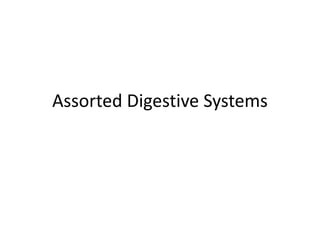himdgut_docx.pptx
•Als PPTX, PDF herunterladen•
0 gefällt mir•166 views
This document discusses and compares the digestive systems of herbivores that ferment cellulose. Foregut fermenters, like ruminants, have a compartment called the rumen before the stomach where microbes break down cellulose. This produces short-chain fatty acids which provide energy and microbes as a protein source. Hindgut fermenters ferment cellulose in chambers after the stomach and intestine. They absorb fatty acids but do not digest microbes, relying solely on diet for protein. Foregut fermentation allows for greater energy and protein extraction from plant materials.
Melden
Teilen
Melden
Teilen

Empfohlen
Empfohlen
Feed Technology for sustainable livestock production

Feed Technology for sustainable livestock productionBihar Veterinary College, Bihar Animal Sciences University, Patna, Bihar, India
Bypass fat and bypass protein in livestock feeding

Bypass fat and bypass protein in livestock feedingBihar Veterinary College, Bihar Animal Sciences University, Patna, Bihar, India
Weitere ähnliche Inhalte
Was ist angesagt?
Bypass fat and bypass protein in livestock feeding

Bypass fat and bypass protein in livestock feedingBihar Veterinary College, Bihar Animal Sciences University, Patna, Bihar, India
Was ist angesagt? (20)
Organic Poultry Production ~ Wales, United Kingdom

Organic Poultry Production ~ Wales, United Kingdom
Bypass fat and bypass protein in livestock feeding

Bypass fat and bypass protein in livestock feeding
Lecture 1 : Grading, Testing & Quality of raw milk

Lecture 1 : Grading, Testing & Quality of raw milk
Ähnlich wie himdgut_docx.pptx
Ähnlich wie himdgut_docx.pptx (20)
Lecture 4 digestion and nutrition 2nd sem 2008-2009

Lecture 4 digestion and nutrition 2nd sem 2008-2009
Kürzlich hochgeladen
IFLA ENSULIB Webinar Series #12: Sustainability - Bringing Nature and Communi...

IFLA ENSULIB Webinar Series #12: Sustainability - Bringing Nature and Communi...Environment, Sustainability and Libraries Section IFLA
Kürzlich hochgeladen (20)
Role of Copper and Zinc Nanoparticles in Plant Disease Management

Role of Copper and Zinc Nanoparticles in Plant Disease Management
IFLA ENSULIB Webinar Series #12: Sustainability - Bringing Nature and Communi...

IFLA ENSULIB Webinar Series #12: Sustainability - Bringing Nature and Communi...
Call Girls in Veraval - 8250092165 Our call girls are sure to provide you wit...

Call Girls in Veraval - 8250092165 Our call girls are sure to provide you wit...
Principle of erosion control- Introduction to contouring,strip cropping,conto...

Principle of erosion control- Introduction to contouring,strip cropping,conto...
Russian Call girls in Dubai 0508644382 Dubai Call girls

Russian Call girls in Dubai 0508644382 Dubai Call girls
Call Girl in Faridabad ₹7.5k Pick Up & Drop With Cash Payment #8168257667

Call Girl in Faridabad ₹7.5k Pick Up & Drop With Cash Payment #8168257667
Research.pptxdfdddddddddddddddddddddddddddddddddddd

Research.pptxdfdddddddddddddddddddddddddddddddddddd
Test bank for beckmann and ling s obstetrics and gynecology 8th edition by ro...

Test bank for beckmann and ling s obstetrics and gynecology 8th edition by ro...
Training Of Trainers FAI Eng. Basel Tilapia Welfare.pdf

Training Of Trainers FAI Eng. Basel Tilapia Welfare.pdf
Hook Up Call Girls Rajgir 9332606886 High Profile Call Girls You Can Get T...

Hook Up Call Girls Rajgir 9332606886 High Profile Call Girls You Can Get T...
How to Reduce Health Risks from Asbestos Dust Not Just limited to Constructio...

How to Reduce Health Risks from Asbestos Dust Not Just limited to Constructio...
Call Girls in Dattatreya Nagar / 8250092165 Genuine Call girls with real Phot...

Call Girls in Dattatreya Nagar / 8250092165 Genuine Call girls with real Phot...
High Profile Escort in Abu Dhabi 0524076003 Abu Dhabi Escorts

High Profile Escort in Abu Dhabi 0524076003 Abu Dhabi Escorts
2,6-Dichlorophenol - Material Safety Data Sheet.pptx

2,6-Dichlorophenol - Material Safety Data Sheet.pptx
Call Girls Brigade Road ( 8250092165 ) Cheap rates call girls | Get low budget

Call Girls Brigade Road ( 8250092165 ) Cheap rates call girls | Get low budget
himdgut_docx.pptx
- 2. Carnivores
- 3. Herbivores • Fermentation of cellulose by gut bacteria • Short chain fatty acids (scfa)(aka volatile fatty acids) produced by bacteria provide and energy source for the herbivore • Foregut fermenters v’s hindgut fermenters • Foregut fermenters/ruminants 1) Fermentation vat (rumen) comes before the “stomach” 2) Food is entirely processed by microorganisms 3) SCFA are absorbed straight through rumen walls This is how ruminants get their energy! 4) True stomach is used to digest excess microorganisms
- 4. Foregut fermenters/ruminants 1) Fermentation vat (rumen) comes before the “stomach” 2) Food is entirely processed by microorganisms 3) SCFA’s are absorbed straight through rumen walls. This is how ruminants get their energy! 4) True stomach is used to digest excess microorganisms. This is how ruminants get their protein.
- 7. Hindgut Fermentation 1) Fermentation chamber(s) comes after the “stomach” and the small intestine. Enlarged hindgut or pouches called “cecae” 2) Microorganisms get what the animal doesn’t use Better if your diet is of higher quality 3) VFA’s are absorbed straight through hindgut walls 4) Excess microorganisms are defecated Hindgut fermenters miss out on microbial protein
- 9. Comparing fermentation strategies Characteristics Foregut /Ruminants Hindgut Where are the microbes? Before stomach After stomach Are microbes digested? Yes No Source of energy Volatile fatty acids Food and VFA Source of protein microbes diet
Hinweis der Redaktion
- Short chain or volatile fatty acids are fatty acids that have carbon chains of 6 carbon atoms or fewer in their structure.
- Ruminant secrete enormous amounts of saliva a day 100-150 liters/day!
- A way to use cellulose without losing the rest of your dietary nutrients